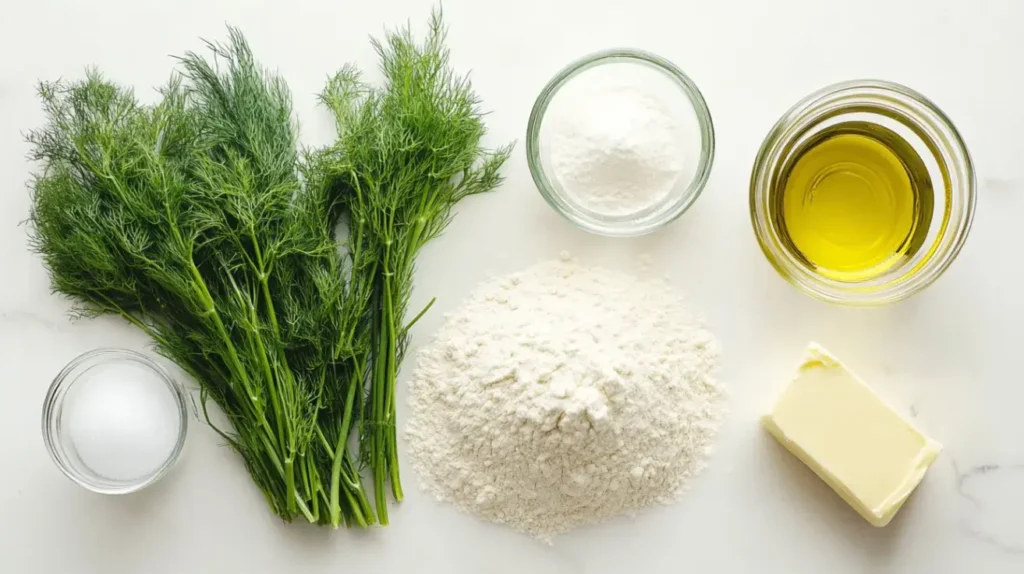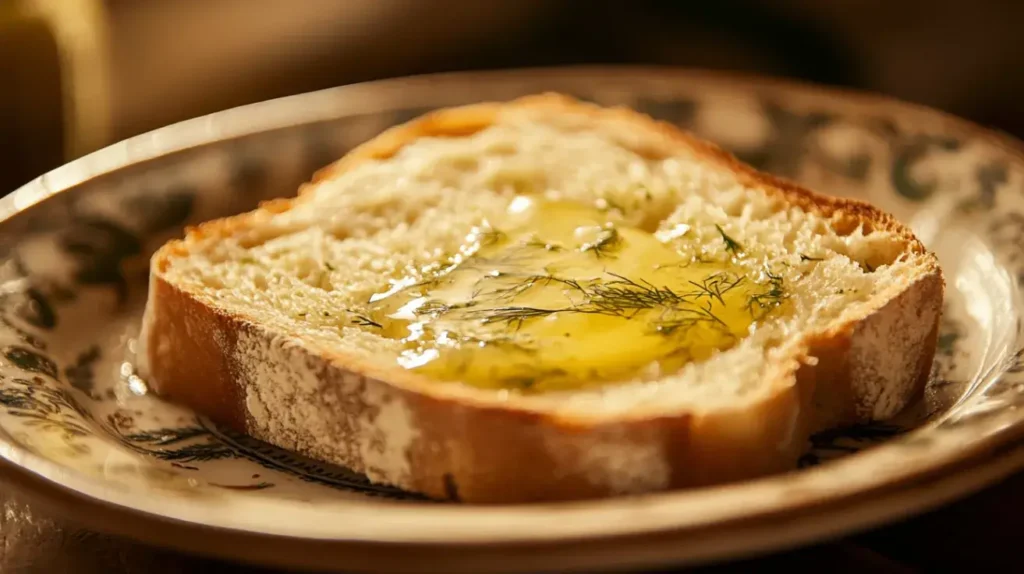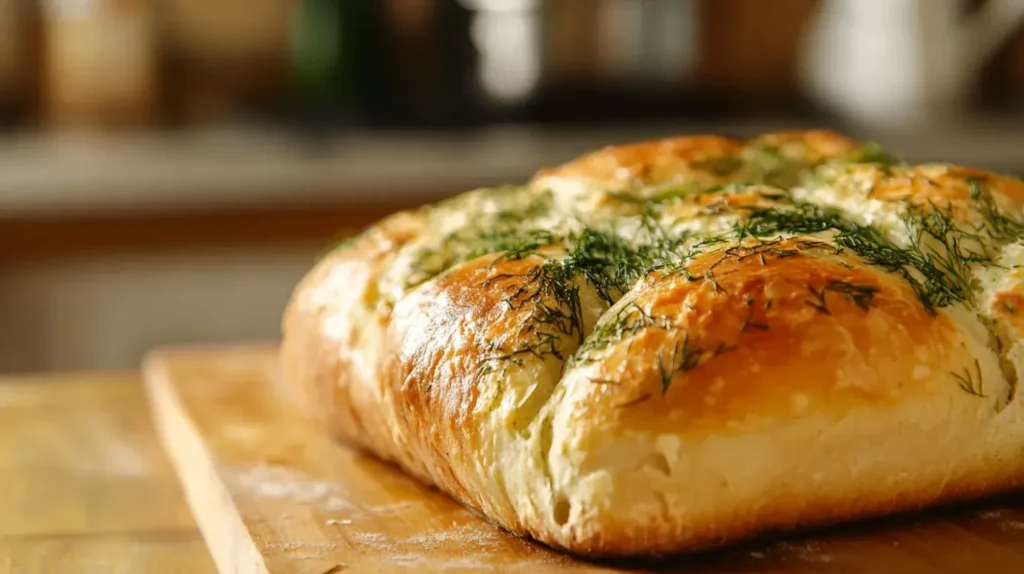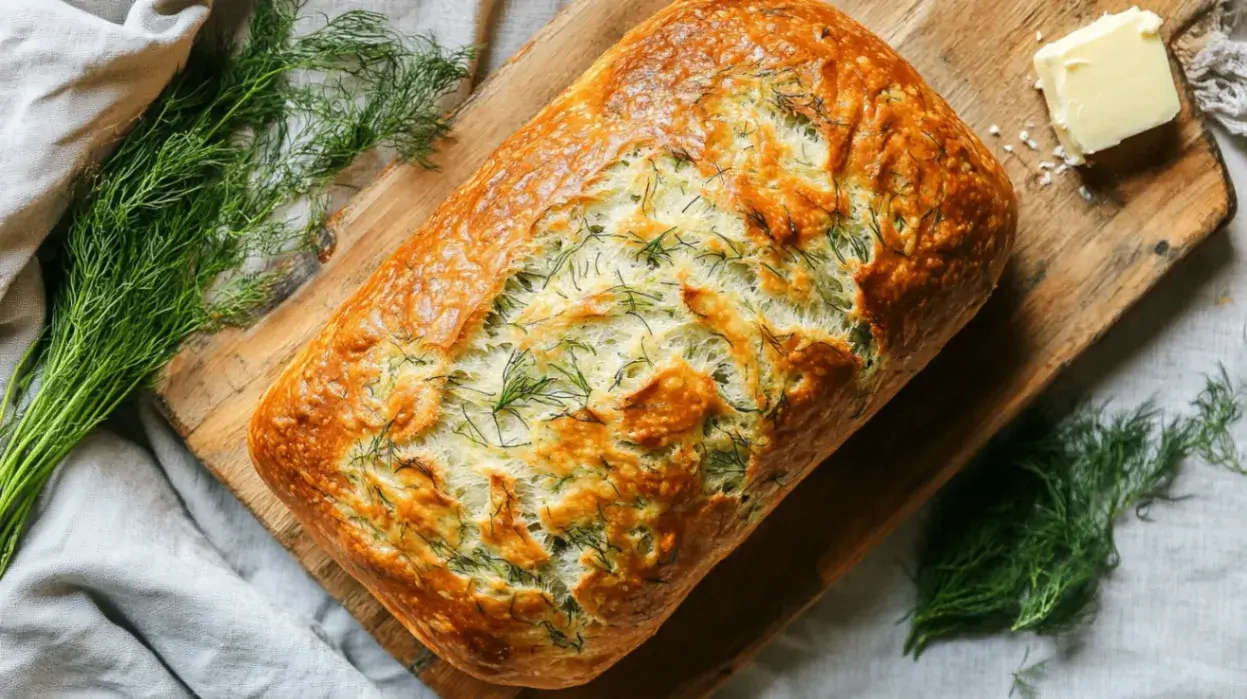The smell of freshly baked bread in the oven is very calming. It makes a house feel cozy and welcoming. For me, dill bread is special. It’s not just the incredible flavor but also the memories it brings back. I remember the first time I tried the dill bread recipe. I discovered it at a cozy little bakery on a family road trip. When I took a bite, I was transported to a world of warm herb-infused goodness.
The combination of dill and bread was new to me. It sparked a passion to recreate that magic in my own kitchen. Dill bread recipe is not an ordinary loaf. It’s a celebration of flavors that can make any meal better. Dill’s unique flavor brings a bright, herby kick that complements a wide range of meals. Whether you enjoy it with soup or as a sandwich base, this bread is sure to impress.
Table of contents
- Ingredients for Homemade Dill Bread
- Step-by-Step Instructions for Making Dill Bread Recipe
- Tips for Perfecting Your Dill Bread Recipe
- Variations and Additions to Dill Bread
- Serving Suggestions for Dill Bread
- Storing and Freezing Dill Bread
- Conclusion and Final Thoughts on Dill Bread Recipe
- COMMUN QUESTION
- Other Bread Recipes You’ll Love
In this article, I’ll share my favorite homemade dill bread recipe, which has never let me down, along with tips and variations to make it your own.
Ingredients for Homemade Dill Bread

To embark on this culinary adventure, you’ll need a handful of simple ingredients that you might already have in your pantry. The foundation of any good bread starts with flour, and for this recipe, I typically use all-purpose flour. It provides the perfect texture and structure.
You’ll also need yeast, which is essential for that delightful rise, along with warm water to activate it. In addition to the basics, the star of the show—dill—comes into play. Fresh dill is my go-to, as its vibrant flavor truly shines through in the bread.
However, if fresh isn’t available, dried dill can work in a pinch. Don’t forget about salt and sugar; they enhance the overall flavor and help balance the yeast’s activity. Lastly, a splash of olive oil adds moisture and richness to the dough.
With these ingredients gathered, you’re well on your way to creating something special.
Step-by-Step Instructions for Making Dill Bread Recipe
Now that we have our ingredients ready, let’s dive into the step-by-step process of making this delightful dill bread. First, I start by activating the yeast. In a small bowl, I combine warm water with sugar and sprinkle the yeast on top.
I let it sit for about five minutes until it becomes frothy—a sign that the yeast is alive and ready to work its magic. This part always excites me; it’s like watching a little science experiment unfold in my kitchen. Then, in a big mixing bowl, I stir together the flour, salt, and freshly chopped dill.
Once the yeast mixture is ready, I pour it into the dry ingredients along with the olive oil. Using a wooden spoon, I mix everything until it forms a shaggy dough. At this point, I transfer the dough onto a floured surface and knead it for about 8-10 minutes until it becomes smooth and elastic.
Kneading is one of my favorite parts; there’s something therapeutic about working with dough. After kneading, I place the dough in a greased bowl, cover it with a cloth, and let it rise in a warm spot until it doubles in size—usually about an hour.
Tips for Perfecting Your Dill Bread Recipe
| Ingredients | Measurements |
|---|---|
| All-purpose flour | 3 cups |
| Active dry yeast | 1 package |
| Sugar | 1 tablespoon |
| Dill seed | 2 tablespoons |
| Salt | 1 teaspoon |
| Milk | 1 cup |
| Water | 1/4 cup |
| Butter | 2 tablespoons |
As someone who has baked countless loaves of dill bread recipe, I’ve learned a few tips along the way that can make all the difference in achieving perfection. One crucial tip is to ensure your water is at the right temperature when activating the yeast—too hot can kill it, while too cold won’t activate it properly. A good rule of thumb is to aim for around 110°F (43°C).
Another tip is to be mindful of your kneading technique. It’s easy to get carried away and overknead the dough, which can result in a dense loaf. Instead, focus on developing gluten by kneading just until the dough is smooth and elastic.
Additionally, don’t rush the rising process; allowing the dough ample time to rise will result in a lighter texture. Lastly, if you want to add an extra layer of flavor, consider incorporating garlic or onion powder into the dough for an aromatic twist.

Variations and Additions to Dill Bread
While the classic dill bread recipe is fantastic on its own, there are numerous variations and additions you can explore to make it uniquely yours. For instance, adding shredded cheese, like cheddar or feta, can create a savory delight that pairs beautifully with the dill flavor. I once experimented with adding sun-dried tomatoes and olives to my dough, which resulted in an Italian-inspired twist that was an instant hit at dinner parties.
If you’re feeling adventurous, consider incorporating nuts or seeds for added texture and nutrition. Chopped walnuts or sunflower seeds can provide a delightful crunch that complements the soft bread beautifully. You can also play around with different herbs; mixing in some rosemary or thyme alongside the dill can create an aromatic blend that elevates your bread to new heights.
Serving Suggestions for Dill Bread
Once your dill bread is baked to golden perfection, it’s time to enjoy it! One of my favorite ways to serve this bread is alongside a warm bowl of creamy potato soup; the flavors meld together beautifully and create a comforting meal on chilly evenings. Alternatively, I love using slices of dill bread recipe as a base for open-faced sandwiches topped with smoked salmon and cream cheese—a combination that always impresses guests.
For brunch gatherings, consider serving dill bread as part of a charcuterie board alongside cheeses, cured meats, and pickles. The herbaceous notes of the bread complement these flavors wonderfully, adding an inviting touch to your spread. Whether you’re enjoying it as part of a meal or slathered with butter as a snack, dill bread is versatile enough to shine in any setting.

Storing and Freezing Dill Bread
After all that hard work in the kitchen, you might be wondering how to store your delicious dill bread recipe properly. If you manage to have leftovers (which is rare in my household), allow the bread to cool completely before wrapping it tightly in plastic wrap or aluminum foil. It can be stored at room temperature for up to three days; however, I find that it’s best enjoyed fresh.
If you want to keep your dill bread for more extended periods, freezing is an excellent option. Before freezing, slice the bread so you can conveniently take out one piece at a time. Wrap each slice in plastic wrap, then store them all in a sealed freezer-safe bag.
When you’re ready to enjoy some bread again, thaw it at room temperature or toast it for a quick warm-up.
Conclusion and Final Thoughts on Dill Bread Recipe
Making dill bread recipe at home is more than following a recipe. It’s a warm and nostalgic experience that brings people together. Its irresistible smell as it bakes and its ability to pair with both meals and snacks are what make this bread truly stand out. I hope it earns a place in your heart, too.
Try this foolproof recipe and make it your own by experimenting with different flavors and additions. Share it with loved ones or enjoy it solo with butter on a quiet afternoon. The dill bread recipe will become a cherished staple in your kitchen, like it has in mine.
COMMUN QUESTION
What is Dill Bread?
Dill bread recipe is a type of bread flavored with dill weed, giving it a unique and savory taste. It’s typically prepared using flour, yeast, dill weed, and a few other simple ingredients to create a flavorful and fragrant loaf.
What Ingredients Do You Need for homemade dill bread?
The ingredients for a homemade dill bread recipe typically include flour, yeast, sugar, salt, dill weed, butter, milk, and sometimes additional flavorings such as garlic or onion powder.
What are the Step-by-Step Instructions for making dill bread?
The step-by-step instructions for making the dill bread recipe involve proofing the yeast, mixing the dough, kneading it, allowing it to rise, shaping it, and baking it in the oven until it turns a golden brown and is fully cooked inside.
What are the Tips for Perfecting Your Bread?
Some tips for perfecting your dill bread recipe include using fresh dill weed for the best flavor, ensuring that your yeast is fresh and active, and allowing the dough to rise in a warm, draft-free environment.
What are Some Variations and Additions?
Variations and additions to dill bread can include adding ingredients such as shredded cheese, chopped olives, or sun-dried tomatoes to the dough for added flavor and texture.
What are Serving Suggestions?
Dill bread can be served on its own as a side dish, toasted and spread with butter, or used as a base for sandwiches and savory toppings.
How do you store and freeze?
Once the dill bread has cooled completely, wrap it securely in plastic wrap or aluminum foil for storage. It can be stored at room temperature for a few days or frozen for more extended storage.
What are the conclusions and Final Thoughts on Dill Bread?
To sum up, dill bread is a tasty and adaptable loaf, perfect for enjoying on its own or as a complement to any meal. With the right ingredients and techniques, you can create a flavorful and aromatic dill bread that will impress your family and friends.
Other Bread Recipes You’ll Love
- Amazing Reka Bread Recipe
- Easy Chicken Bread Recipe
- 5 Simple Steps To Make Panera Bread Chicken Salad
- 3 Foolproof Steps To The Best Cinnamon Donut Bread
Homemade Dill Bread Recipe
Ingredients
- 3 cups All-purpose flour
- 1 package Active dry yeast
- 1 tablespoon Sugar
- 2 tablespoons Dill weed (fresh or dried)
- 1 teaspoon Salt
- 1 cup Milk
- 1/4 cup Water
- 2 tablespoons Butter (melted) Optional: Use olive oil for a different flavor
Instructions
- Activate the yeast: In a small bowl, combine warm water (about 110°F/43°C) and sugar. Sprinkle the yeast on top and let it sit for 5 minutes, until frothy.
- Mix dry ingredients: In a large bowl, whisk together the flour, salt, and dill weed (fresh or dried).
- Combine wet and dry ingredients: Add the yeast mixture and melted butter to the dry ingredients. Stir until a shaggy dough forms.
- Knead the dough: Turn the dough onto a floured surface and knead for about 8-10 minutes, until smooth and elastic.
- Let the dough rise: Place the dough in a greased bowl, cover it with a clean cloth, and let it rise in a warm place for about 1 hour or until it doubles in size.
- Shape the dough: Punch down the risen dough, then shape it into a loaf. Place it in a greased loaf pan.
- Second rise: Cover the dough with a cloth again and let it rise for another 30 minutes.
- Preheat the oven: While the dough is rising, preheat the oven to 375°F (190°C).
- Bake the bread: Bake the dough in the preheated oven for 25-30 minutes or until the bread is golden brown on top and sounds hollow when tapped on the bottom.
- Cool and serve: Let the bread cool for at least 10 minutes before slicing and serving. Enjoy!

